As a dietitian specializing in the low FODMAP diet and weight management protein shakes and meal replacement shakes are a frequent topic. You may be wondering, what is the difference between a protein shake and a meal replacement shake?
- Meal replacement shakes often contain protein, carbohydrates, fats, and are fortified with micronutrients
- Protein shakes are often more protein based.
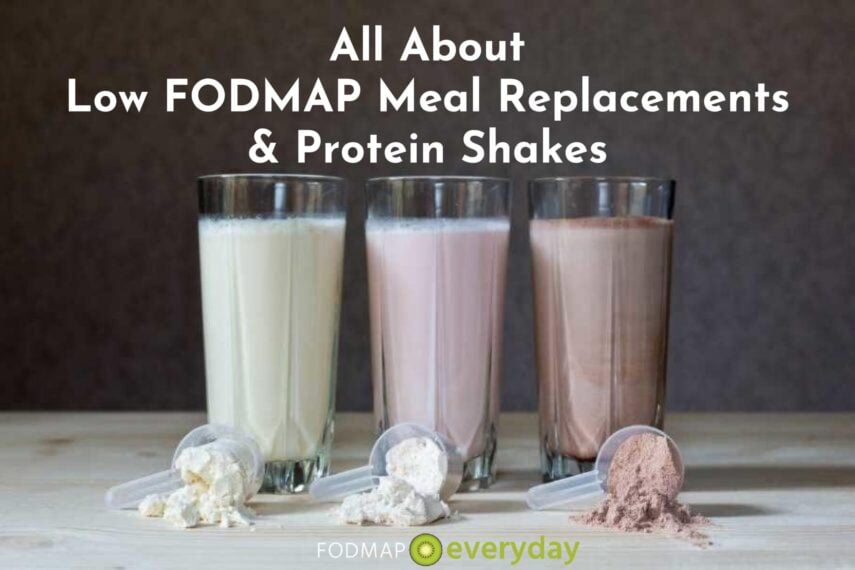
Meal replacements are encouraged if they are providing the majority of one’s calorie needs. Either is acceptable if used as an occasional meal substitute, snack, or supplement. Ultimately, I want my patients to cook and eat real whole foods, however this is not always a realistic approach.
Life can be hectic and reaching for a protein shake can be a better option than skipping a meal or grabbing a less nutritious snack such as a candy bar.
You might also be interested in our article, How To Choose A Low FODMAP Energy Bar.
It is highly recommended to seek advice from a dietitian before starting the low FODMAP diet and when devising a nutrition plan for weight loss or gain, especially when using meal replacements since these vary greatly and may be contraindicated with some medical conditions.
- Pros of Meal Replacements & Protein Shakes & Protein Powders
- Cons of Meal Replacements & Protein Shakes & Protein Powders
- Good for On-The-Go
- Read Labels for FODMAPs
- Portion & Serving Size Counts
- Lab Tested Low FODMAP Certified Protein Sources
- Additional Information On Pea Protein & Soy Protein
- High FODMAP Ingredients To Avoid
- Ingredients With Unknown FODMAP Content
- Low FODMAP Protein & Meal Replacement Additional Ingredients
- What About Bone Broth?
- Which Low FODMAP Protein Powders, Shakes or Meal Replacements To Buy?
- Our Smoothie Tip
- The Takeaway
Pros of Meal Replacements & Protein Shakes & Protein Powders
- A quick and easy portable meal or snack that one can reach for when away from home or when time is short.
- A treatment option for weight reduction, meal replacements can help fill in the gaps instead of skipping meals and can provide a calorie and portion controlled meal. Meal replacement shakes are often lower in calories than a typical meal contributing to an energy deficit.
- Provide supplemental protein to help meet increased protein needs for wound healing, cancer therapies, and hemodialysis.
- Promote weight gain in those struggling with involuntary weight loss. Weight gain can occur if shakes are consumed in addition to one’s normal eating habits such as in-between meals or before bed. Meal replacement shakes add extra calories without negatively affecting one’s appetite since they pass through the stomach faster than solid foods.
- Pre and post exercise fuel. Liquid calories such as meal replacements and sports drinks are often encouraged prior to intense workouts since they leave the stomach quickly and are less likely to cause gastric distress during a workout. A protein-carbohydrate rich snack is often advised after an intense workout or endurance exercises to replete glycogen stores and achieve muscle mass gains.
- Boost vitamins, minerals, antioxidants and fiber in dietary patterns that lack adequate nutrient dense foods.
- Easy to swallow for those with swallowing difficulties.
Cons of Meal Replacements & Protein Shakes & Protein Powders
- They empty out of the stomach which can result in hunger sooner than consuming a solid, fiber rich meal.
- Promote boredom if consumed in place of meals for a long duration of time.
- Challenges when transitioning to regular foods if consumed as main nutrition source with a weight loss program since one often does not always learn how to make healthful choices with real foods. Often times when the program ceases, we return to our old eating habits and weight regain can occur.
- Cost – on average prices meal replacement shakes range from $2 to $5 each. When used as a sole source of nutrition in a weight loss program this can cost upwards of $300 per month.
- May contain artificial sweeteners, sugar alcohols, sugar and less than desirable food additives.
- Lack intact dietary fibers found in whole foods such as fruit, vegetables, legumes, and whole grains.
Good for On-The-Go
Low FODMAP meal replacements and protein shakes can be helpful for those suffering from irritable bowel syndrome (IBS) since they are easily digestible, convenient and provide a low FODMAP meal or snack option. These can be easily consumed when hunger strikes, which can help keep food anxiety under control and portions in check by helping one not get overly hungry.
Read Labels for FODMAPs
Unfortunately, many meal replacements and protein shakes contain high FODMAP ingredients making them unsuitable for the Elimination phase. They might also contain superfoods, herbal supplements, sweeteners, isolated fibers, digestive enzymes, and probiotics which have unknown FODMAP content and/or might trigger IBs symptoms.
As a RDN I often help my patients decipher food labels to determine if a product is FODMAP appropriate using my best clinical judgment since few protein shakes and meal replacements are low FODMAP certified.
High FODMAP Foods With Low FODMAP Serving Sizes
For example, you might come across beet powder. Beets are considered moderate to high in fructans and galactans with serving sizes of 30 grams or more. Beet powder used for coloring is likely low FODMAP, however a large dose of beet powder which may be added to provide a therapeutic dose to enhance athletic performance, may be too much and probably best to avoid in the Elimination phase of the low FODMAP diet.
Broccoli crowns are low FODMAP up to ¾ cup (75 g), however this is hard to translate what this equates to in broccoli powder.
We have an article for you, High FODMAP Foods with Low FODMAP Serving Sizes.
Portion & Serving Size Counts
The low FODMAP diet is not black and white. A 1 teaspoon (5 g) amount of agave has been lab tested as Low FODMAP. But more than that veers into Moderate and High FODMAP territory.
What this means is that if an ingredient is far down on an ingredient list and present in small quantities, your product choice might be fine.
There are lab tested and certified products that contain small amounts of what one typically thinks of as high FODMAP ingredients.
Always pay attention to where an item is on an ingredient list, the recommended serving sizes and, to take the guesswork out of the equation, whether the product has been lab tested and certified as low FODMAP.
We have an article for you to review on low FODMAP serving sizes.
Lab Tested Low FODMAP Certified Protein Sources
The following proteins have been lab tested and certified low FODMAP by Monash University or FODMAP Friendly either as standalone ingredients or are used in commercially prepared products.
Please refer to Monash University & FODMAP Friendly smartphone apps for serving size amounts and/or the products that these items appear within:
- Casein
- Egg Protein
- Fenuflakes (high protein-high fiber, low fat-ultra low carb derived from fenugreek seeds)
- Hemp Protein
- Milk Protein Isolate
- Pea Protein
- Pea Protein Isolate
- Pumpkin Seed Protein
- Rice Protein
- Sacha Inchi Protein
- Soy Protein Isolate
- Sprouted Brown Rice Protein
- Sunflower Protein
- Whey protein concentrate
- Whey protein isolate
Additional Information On Pea Protein & Soy Protein
For a full discussion of pea protein and pea protein isolate, please refer to our article, Is Pea Protein Low FODMAP? The short answer is that both Monash University and FODMAP Friendly have lab tested pea protein isolate on its own and also products that contain both pea protein and pea protein isolate and they each do have low FODMAP serving sizes.
How Pea Protein Is Made
Pea protein is made from dried yellow peas by removing the outer shell (which contains the insoluble fibers) of the pea through a milling process and then removing the fiber and starch (oligosaccharides) in a wet filtration process.
Pea proteins are not all the same as the protein and carbohydrate content many vary from brand to brand based on processing. Pea protein or pea protein concentrate may contain small amounts of the pea fiber versus a pea protein isolate. Opting for a pea protein isolate based protein powder or one containing 0-1 gram of carbohydrates is likely to have a lower FODMAP content.
My recommendations are to approach pea protein with caution and test tolerance with a small portion and increase as tolerated to full serving. If you have been a regular pea protein consumer and IBS symptoms are under good control, please continue to enjoy this plant-based protein powder.
Here is an article on pea protein and FODMAPs.
Soy Protein
Soy protein isolate is a protein made from defatted soy flakes where the fiber and sugars (which contain the oligosaccharides) are separated and removed. Soy protein isolate is 90% protein and appears in products lab tested and certified by FODMAP Friendly, so we know that some amount is low FODMAP on its own. Soy protein concentrate contains more of the fiber and sugars (aka oligosachharides) resulting in a higher FODMAP content.
High FODMAP Ingredients To Avoid
The following chart shows you some ingredients that are often found in protein shakes and meal replacements and are considered high FODMAP. We suggest avoiding these during Elimination. Note that while natural flavors can be an issue, if they are in amounts of 2% or less they are unlikely to trigger symptoms.
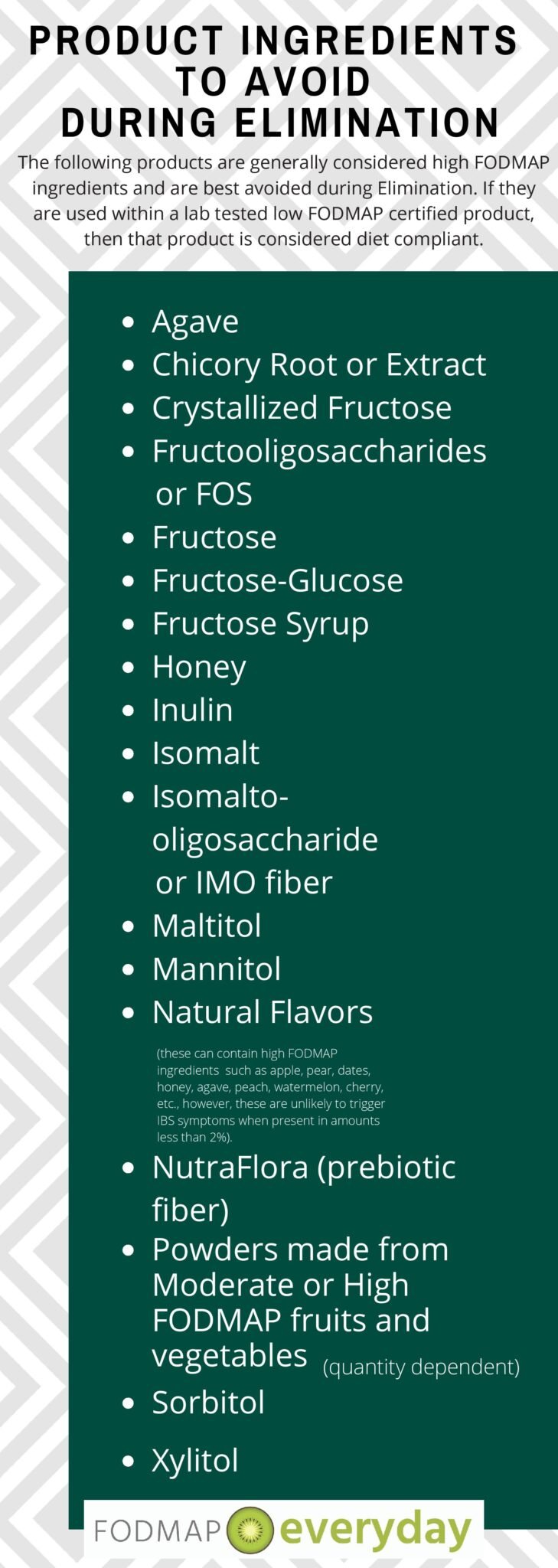
Ingredients With Unknown FODMAP Content
The following chart shows you some ingredients that are commonly found in protein shakes and meal replacements that have unknown FODMAP content or create an unknown variable. We suggest avoiding all of these during Elimination. Please consider reading our article on enzyme supplementation.
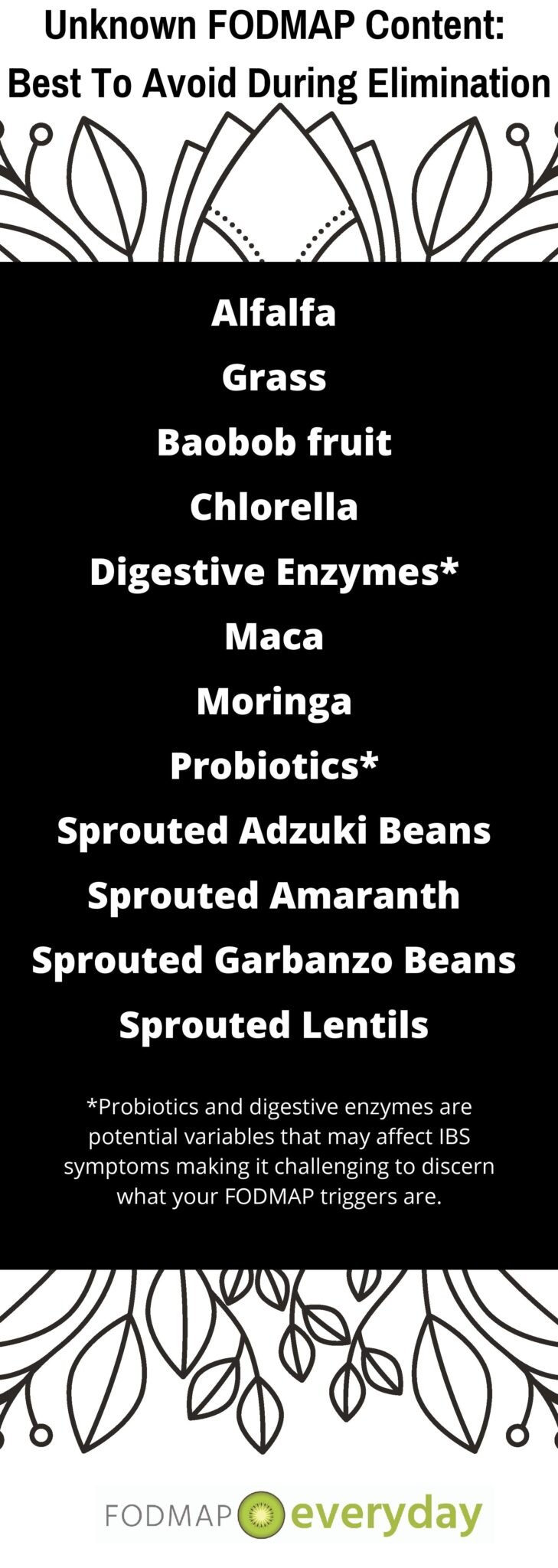
Low FODMAP Protein & Meal Replacement Additional Ingredients
Most shakes and meal replacement drinks contain additional ingredients beyond protein, often in smaller amounts. All of these ingredients listed below have appeared in lab tested and certified low FODMAP products.
Items that can be found on the Monash and FODMAP Friendly apps (such as acai, agave, cocoa and honey) are not included below, as they can be looked up individually.
The purpose of this list is to demonstrate that some ingredients that have not been lab tested on their own have been used in certified low FODMAP products and therefore deserve a second look. It is not meant to be an exhaustive list, but rather to show some examples.
Since these ingredients have not been lab tested on their own, we do not know their exact low FODMAP serving sizes.
- Beet Juice Powder
- Camu Camu Powder
- Cold Brew Coffee Extract
- Cordyceps
- Dried Raspberries
- Ginseng
- Greens Blend (OWYN products: Broccoli, Spinach, Kale),
- Hibiscus Flower Powder
- Kelp Powder
- Lemon Oil
- Maitake
- Maple Sugar
- Monk Fruit
- Monk Fruit Extract
- Peppermint Oil
- Vegetable Fiber
What About Bone Broth?
We are calling out bone broth on its own as it is a very trendy option.
Bone broth contains several amino acids including L-glutamine, proline and glycine found in the collagen. These amino acids have been touted as anti-inflammatory agents that help heal “leaky gut” by improving intestinal integrity, however, there is inadequate evidence to support bone broth or collagen for IBS symptom improvement.
Recent research suggests increased risk of lead contamination with diets rich in bone broth. As a RDN I would advise caution with bone broth powder and only consume on an infrequent basis.
You can also read more about bone broth in our article on IBS Diet Fads.
Which Low FODMAP Protein Powders, Shakes or Meal Replacements To Buy?
Everything individually listed below is easily available in our Amazon Shop – just follow this link.
Certified Low FODMAP Protein Powder & Low FODMAP Protein Shake or Drink Products
Please note that the OWYN products were lab tested and certified by Monash University and while they no longer participate in the certified licensing program, the ingredients and formulas have remained the same. This was confirmed via private correspondence with OWYN.
The Three Arrows Collagen Peptides were lab tested and certified by FODMAP Friendly and while they no longer participate in the certified licensing program, the ingredients and formulas have remained the same. This was confirmed via private correspondence with Three Arrows.
- Casa de Santé Vegan Protein in Vanilla
- Casa de Santé Advanced Whey Protein– Vanilla & Chocolate
- Hum Core Strength Vegan Vanilla Protein Powder
- Musclegen Performance Nutrition Genepro Medical Grade Protein
- OWYN Cold Brew Coffee Protein Drink
- OWYN Cookies n’ Cream Protein Drink
- OWYN Dark Chocolate Protein Drink
- OWYN Turmeric Golden Mylk Protein Drink
- OWYN Vanilla Protein Drink
- OWYN Strawberry Banana Protein Drink
- Stellar Lab Whey Protein Shake- Vanilla, Chocolate & Salted Caramel
- Stellar Lab Raw Vegan Plant Protein Shakes – Vanilla & Chocolate
- Else Plant-Based Complete Nutrition – approved for children
- Three Arrows Collagen Peptides
- Tumlove Chocolate
- Tumlove Vanilla
- FODMAP Foods LLC (several flavors)
- The Healthy Mummy (several flavors)
- Blissful Raw Cacao Vegan Protein
- Genepro
- AdVital Complete Nutrition (several flavors)
- BetterBlends Gut Friendly Protein (several flavors)
- Element Gold (several flavors)
- Glow Elixir Protein
- Superflora (several flavors)
Additional Protein Powder, Shakes and Drinks Products To Try
- About Time Whey Protein Isolate – Unflavored
- Ancient Nutrition Bone Broth Protein Powder – Pure Flavor and Turmeric
- BioChem 100% Whey Protein – Vanilla and Natural
- BiPro Whey Protein Isolate – Unflavored
- Bob’s Red Mill Pea Protein Powder
- BOOST High Protein Complete Nutrition Drink – Rich Chocolate, Very Vanilla, and Creamy Strawberry
- Boost Optimum Advanced Nutrition Drink – Rich Chocolate and Creamy Vanilla
- BOOST Essential Unflavored Protein Powder
- EAS AdvantEDGE Carb Control Shakes – Vanilla and Rich Dark Chocolate
- Ensure Original Nutrition Shake – Milk Chocolate, Vanilla, Strawberry, Dark Chocolate, Butter Pecan, Coffee Latte, and Banana Nut
- Ensure High Protein Nutrition Shake – Milk Chocolate, Vanilla, and Strawberry
- Ensure Plus Nutrition Shake – Milk Chocolate, Vanilla, Strawberry, Dark Chocolate, and Butter Pecan
- Evolve Real Plant – Powered Protein Shake – Ideal Vanilla, Classic Chocolate, and Mellow Mocha
- Fairlife Core Power Elite – Chocolate and Vanilla 42G
- Further Food Collagen Peptides Protein Powder– Unflavored
- Growing Naturals Organic Rice Protein – Original and Strawberry
- Growing Naturals Pea Protein Powder – Original, Vanilla, Chocolate and Strawberry
- Isopure Zero Carb Protein Powder, 100% Whey Protein Isolate – Unflavored
- Jarrow Brown Rice – Vanilla and Chocolate
- Jarrow Formulas Virgin Whey Protein Isolate– Unflavored
- Jay Robb Egg White Protein – Unflavored
- Jay Robb Whey Protein Isolate – Unflavored, Vanilla and Chocolate
- Life Extension Whey Protein Isolate– Natural Vanilla Flavor
- Left Coast Performance Bone Broth Protein Powder – Original
- Naked Pea Protein – Unflavored, Vanilla and Chocolate
- Naked Rice Organic Brown Rice Protein Powder
- Nature’s Best Isopure Zero Carb Protein Powder, 100% Whey Protein Isolate – Unflavored
- NOW Sports Egg White Protein Powder
- NOW Sports Pea Protein Powder
- Nutribiotic Brown Rice Protein-Plain – Vanilla and Chocolate
- Nutrabio 100% Hydrolyzed Whey Protein– Unflavored
- Organic Valley Organic Balance Milk Protein Shake – Dark Chocolate
- Organic Valley Organic Fuel High Protein Milk Shake – Vanilla
- Paleo Thin Protein Egg White Powder
- PreProtein Whey Protein Isolate
- PBfit All-Natural Peanut Butter Powder
- Sports Research Collagen Peptides
- Trader Joe’s Organic Pea Protein – Unflavored
- Unjury Planted Pea Protein– Unflavored
- Unjury Whey Protein Powder– Unflavored
When trialing a most-likely low FODMAP product start with half of the serving size when symptoms are under good control to test your tolerance. If you do fine after 24 hours of observation increase to full serving and monitor symptoms.
Our Smoothie Tip
Once you buy your protein powder you are going to want to use it to make a smoothie or beverage. Here are my low FODMAP high protein smoothie Tips. Use your Monash app to keep track of the serving sizes for additional ingredients and be mindful to avoid stacking.
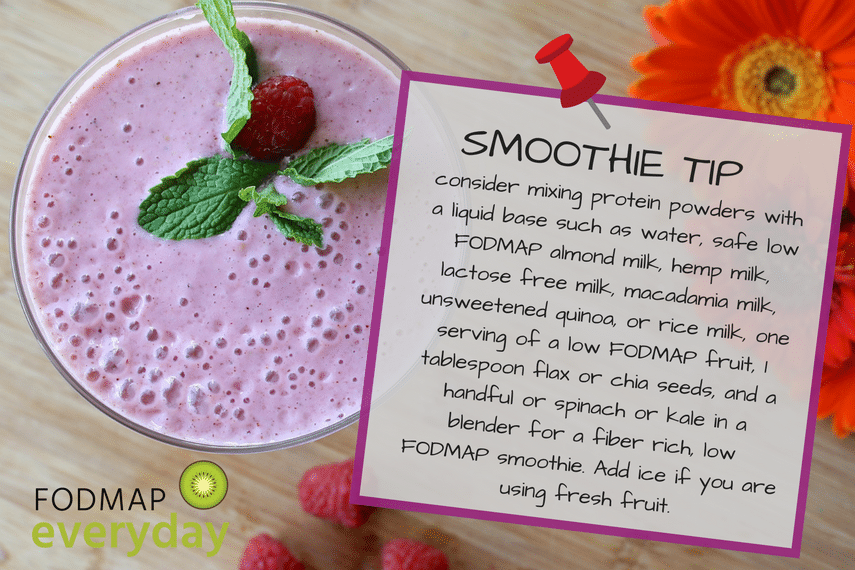
The Takeaway
Low FODMAP meal replacement shakes and low FODMAP protein powders and shakes can be part of your low FODMAP lifestyle.
Read more about specific low FODMAP protein powders in our companion article, Low FODMAP Protein Powders: What To Buy and What To Avoid.
If a product has been lab tested and certified by Monash University or FODMAP Friendly, then you can rest assured that it is low FODMAP, if used as directed. I have personally vetted the products listed under “Additional Products To Try”. There are many products to incorporate into your low FODMAP diet, whether you want unflavored, chocolate or fruit flavored, animal-based proteins, such as egg or whey, or whether you are looking for plant-based proteins.
It is sometimes easy to overdue portions when it comes to drinks and smoothies. As always, begin with recommended serving sizes and eat to your tolerance.
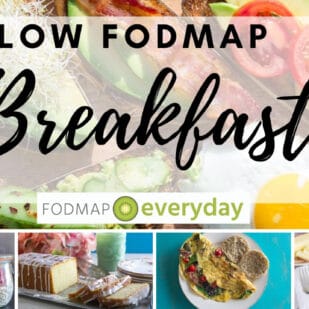
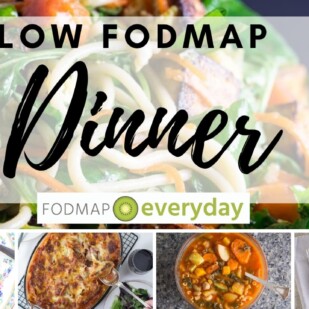
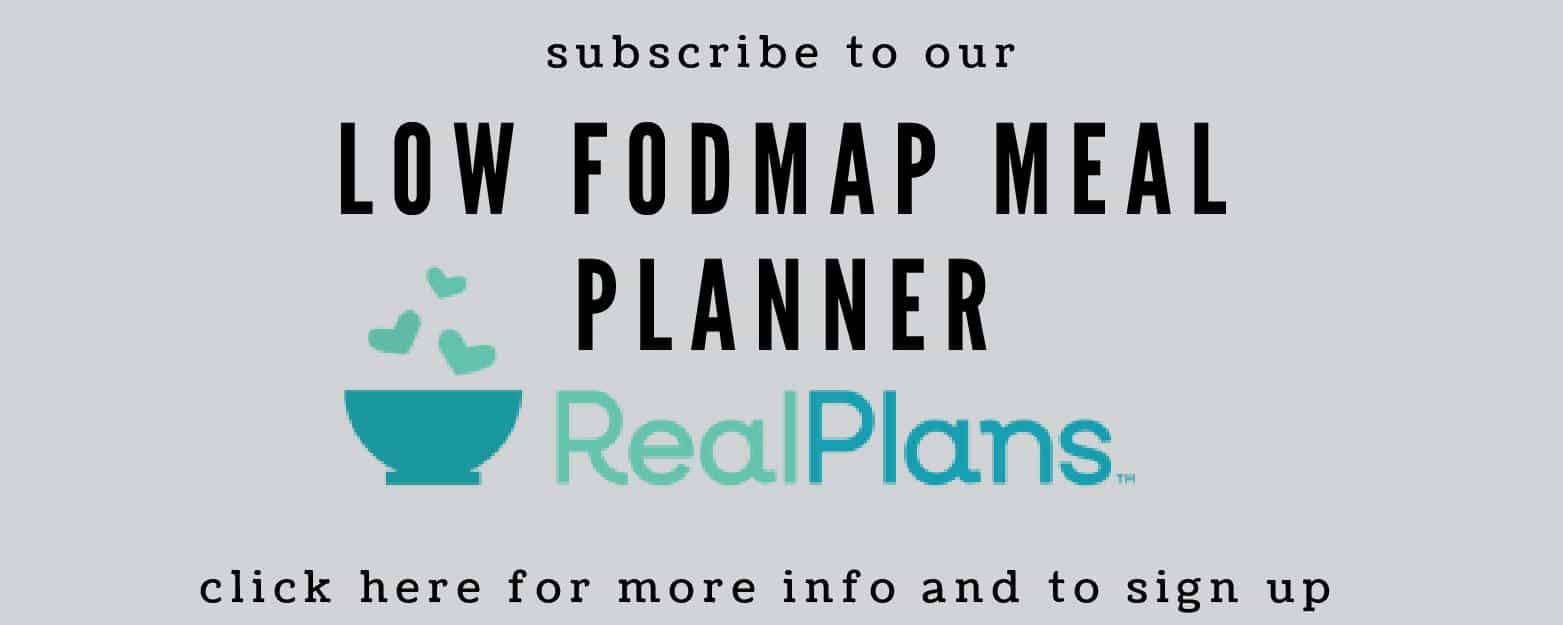
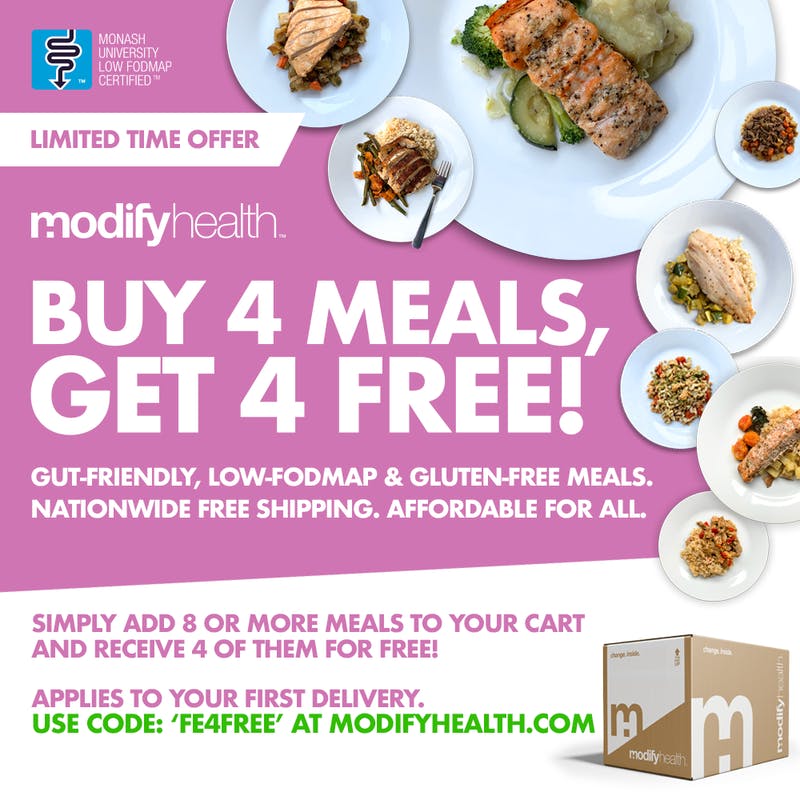



Hi DeDe, OWYN Dark Chocolate Plant Based Protein Powder container lists these ingredients:
The Owyn protein blend (pea protein concentrate, pumpkin protein, chia), cocoa, cane sugar, superfoods; greens blend (zucchini, spinach, broccoli, kale), flaxseed, natural flavors, salt, monk fruit extract, aquamin (mineralized seaweed), silica, and lactospore bacillus coagulants (1 billion cfu). Thank you very much for your thoughts.
Hi Rhonda, the protein blend is the same as in the one that was in the products they tested except this has the addition of chia. The superfood blend could be a FODMAP issue at some portion. Couple of questions for you: have you been using it and have you been digesting it OK? Or have you been using it and having symptoms? Or are you stable and in Challenge phase and considering this? All things to think about. My best is that at some small amount it would be low FODMAP – we just dont know what that serving size is. Have you read our article about Serving Sizes and also about what to do with untested foods?
Yes- I am also very confused by many of the products you recommend as they contain flavoring/ probiotics/ fruit and vegetable sources that are not advised. Also, what about those of us who cannot tolerate soy or corn?
Hi Tracy, since the low FODMAP diet is neither soy nor corn-free, those are not something we address, and we leave it to those who do need to avoid these ingredients to do their own homework. As to your other queries, the low FODMAP diet is “low FODMAP” not “no FODMAP” and this article was written by a Monash trained registered dietitian who has reviewed every product listed, has communicated directly with manufacturers where necessary, and also remember that when an item is less than 2% it is unlikely to trigger symptoms. You can review this article for additional info on levels of ingredients.
Hello,
If I could please ask a relevant question on the meal replacements you had said you vetted yourself- Ensure plus (the one with 350 calories) tends to have 20-22 grams of sugar depending on the flavor. As I am seeing it, that is considerably more sugar than the 1 tablespoon per sitting that is allowed as low FODMAP. Isn’t that violating the diet?
Thank you.
The serving sizes on the Monash app reflect low FODMAP servings BUT ALSO are often guided by “Australian Healthy Eating Guidelines”. We wish this were not so, as the app is used by all of us for FODDMAP info and not necessarily general nutritional info, but this is out of our hands. Sugar, as in regular white table sugar, does not have more fructose than glucose, therefore it will be low FODMAP at any amount. Monash just doesn’t want to suggest that you have a cup of it, which makes general nutritional sense. Unfortunately, the app entry makes things confusing for sleuths like you who are trying to read labels and make decisions. You can read more in our Explore an Ingredient: Sugar.
Thank you for the very helpful explanation Dede; other websites seem to miss what you are saying here. I am just getting started, and am glad to know I don’t have to disqualify everything with more than a Tbsp of sugar. The Ensure is a useful replacement in a pinch to avoid eating something bad when there is nothing else available at the time.
Joe, welcome to our community! We work very hard to bring you the most thorough and helpful info – which is not always clear elsewhere. Enjoy poking around I am sure you will find plenty of recipes and articles that speak to you.
Does ensure have dairy ? I was told not to have dairy Can you explain for me. Also I would like to gain 5 pounds any suggestions , it seems hard to gain weight in Fodmap.
Hi Sandy, a couple of things. First of all Ensure is considered lactose-free but is not dairy free. The low FODMAP diet is not a dairy-free diet, FYI. If your medical team has suggested you stay away from dairy proper, then this would not be the drink for you. But please read more about the difference between dairy-free and lactose-free; they are not the same thing. I have also linked an article for you about gaining weight.
Great Products. Keep sharing.
I have used Orgain Organic Protein protein powder in the creamy chocolate fudge and the vanilla bean, for a long time now. I like the price and the taste. However, I am always bloated after having a smoothie. I use unsweet coconut milk (Silk Brand), ice frozen ripe bananas, peanut butter and collagen powder. That is one recipe and the other is frozen blueberries, coconut milk and ice. Bloated, every dang time.
Any ideas??
My first idea is that quantity is the issue. It is common for smoothies with multiple ingredients to present a situation of just too many foods in too large quantities when all combined together. Check out this article, then I would maybe try halving your usual portion and see if you get any relief. If not, I would cut way back on ingredients and start from scratch. Start with protein powder, ice and banana. Or Collagen, coconut and blueberries. At the very least make sure you are using low FODMAP amounts of everything and not stacking.
Could be the collagen… that does it for me! Turns me into a balloon!
It is always helpful when we can determine individual triggers.
I like plain chocolate protein shakes.
I would prefer vanilla.
Hey Deborah! You are the winner of our weekly newsletter giveaway! I will reach out to you by email. Congratulations! – Robin
I love vanilla! And use banana turmeric cinnamon berries added to coconut milk almond milk or lactofree milk 🙂
Very informative and good reference article. I am doing the diet for my severely autistic and development delayed son. As he can’t communicate very well we have to read his symptoms through his behaviour making it very hard to fine tune the diet. Breakfast is not a preferred meal for him so we’re finding that making shakes some mornings are the thing because if anything has chocolate in it he will drink it . This article has provided me a lot to go on and will aid in changing up and fine-tuning his morning shakes.
Ruth, what a great mother you are! Looks like you are an ace at research and your son is blessed to have you. We are so happy we are helping you both. Thank you for letting us know.
I like your article and the presentation of information. This article is a godsend for anyone looking to understand the basics of nutrition with protein and protein shakes. You managed to put a lot of valuable information into the article and present it in ordinary language so that everyone could understand it. Before reading this article, I did not understand all that is necessary to maintain such a diet with added protein in the diet. And I agree, if there is no opportunity to have lunch or a snack with something useful, then this is the best way out of the situation.
How about vega one either chocolate or french vanilla or garden of life raw meal
Which vega in particular? The Garden of Life has too many unknowns that have not been lab tested
Hi I want to know if “Labrada Nutrition, Lean Body, Hi-Protein Meal Replacement Shake, Chocolate,”is low fodmap.
I’m trying to gain weight and on the low fodmap diet.
Hi there, the whey protein concentrate as the first ingredient makes this a poor choice; it will be higher in lactose than others. How do you do with lactose? You would also need to call manufacturer and ask about natural favors.
Hi I am wondering if MyProtein Impact Whey Isolate in chocolate smooth or salted caramel are low fodmap. The company states the lactose content for these products is 1% which would equate to 0.3g in a 30 gram serving I usually have. Both have artificial and natural flavoring which is ambiguous as to what’s used in the salted caramel, though I don’t think it would be any of the above mentioned fruits nor garlic/onion. The chocolate smooth has cocoa powder which is low fodmap at 8g. I just bought a 5lb bag of the salted caramel right before my gastro told me to try low fodmap. I follow a strict fitness plan and have high protein requirements, and it would be very expensive to buy all new low fodmap protein powders. I also have a couple different tubs of Pescience Select protein in chocolate truffle, snickerdoodle and cake pop. The website for Pescience states all Select proteins have <1g of lactose. However they each have 1-3g of carbs so it's unclear if that claim is true but maybe the carbs are coming from flavoring ingredients. Do you have any idea whether any of these protein powders I mentioned would be considered low fodmap? I'm on 5th day of elimination and would greatly appreciate the insight.
Hi there. In general if a serving size is 1g or less of Sugars, then the lactose is low enough to be considered low FODMAP. Also in general whey protein isolate is low FODMAP while concentrate is not. Cocoa is a whole other thing. Monash has made a mess of that. You can read more HERE. Any flavorings in powders such as these are probably in low enough amount to not make a difference. Artificial flavors are never a FODMAP issue. You might check with manufacturer about natural favorings to rule out inulin. We have several articles on the site that address exercise and athletes such as THIS one, THIS one and THIS one. Hope this all helps.